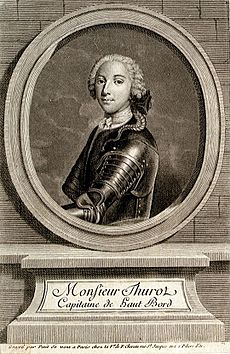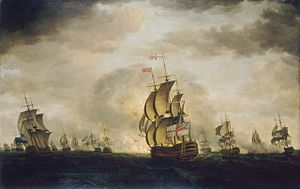John Elliot (Royal Navy officer) facts for kids
Quick facts for kids
John Elliot
|
|
|---|---|
| Born | 1732 Scotland |
| Died | 20 September 1808 Monteviot House, Roxburghshire |
| Allegiance | |
| Service/ |
|
| Rank | Admiral |
| Commands held | HMS Hussar HMS Aeolus HMS Gosport HMS Chichester HMS Firme HMS Portland HMS Trident HMS Edgar Downs Station |
| Battles/wars | |
| Relations | Sir Gilbert Elliot, 2nd Bt (father) Jean Elliot (sister) |
John Elliot (born 1732, died 1808) was a brave Scottish officer in the Royal Navy. He fought in important wars like the Seven Years' War and the American War of Independence. He became a high-ranking admiral and even served as governor of Newfoundland for a short time.
Elliot joined the navy as a young man. He became a post-captain during the Seven Years' War. He commanded the ship HMS Aeolus and became famous for capturing a French privateer named François Thurot. This victory made him a hero. After the war, he continued to serve during the American War of Independence. He took part in big battles like the relief of Gibraltar and the Battle of Cape St Vincent. He also fought in the Battle of Ushant. After the wars, he became an admiral. He passed away in 1808.
Contents
John Elliot was born in Scotland in 1732. He was the fourth son of Sir Gilbert Elliott, 2nd Baronet. He joined the Royal Navy in 1740 after studying at the Royal Naval Academy in Portsmouth.
He served on several ships, including HMS Augusta and HMS Princess Royal. He also spent time on HMS Chesterfield and HMS Assistance. In 1752, he passed his test to become a lieutenant. He officially became a lieutenant in 1756, joining HMS Scarborough. His brother, Gilbert Elliot, became a Lord of the Admiralty. This helped John move up the ranks faster. He was promoted to commander in 1757, and then to post-captain soon after. His first command was HMS Hussar.
Fighting in the Seven Years' War
In 1758, Elliot was given command of the new 32-gun ship HMS Aeolus. In March 1759, while sailing near Brittany, his ship and HMS Isis found four French ships. Two of the French ships escaped, but Aeolus fought the 20-gun Mignonne. Elliot captured the Mignonne after a tough fight. The French ship lost its commander and many crew members. Aeolus only had a few wounded.
Elliot spent the rest of 1759 sailing with Sir Edward Hawke's fleet. In January 1760, his ship was caught in bad weather and had to stop at Kinsale in Ireland for supplies. While there, he received an urgent letter. The French privateer François Thurot had landed near Carrickfergus and taken over the town. Elliot was the only naval officer nearby.
Defeating the Privateer Thurot
Elliot quickly got his ships ready. He was joined by two other ships, HMS Brilliant and HMS Pallas. They sailed to Carrickfergus, but Thurot had already left. Elliot chased him and found the French ships on February 28, 1760. The battle happened off the Isle of Man.
After a fierce fight, Thurot's ships were badly damaged. Thurot himself was killed during the battle. About 300 French sailors were killed or wounded. The British had fewer losses. Elliot's ship, Aeolus, had four killed and 15 wounded. Thurot's body washed ashore and was buried with military honors.
Elliot and his captains were thanked by the British and Irish parliaments. They also received the freedom of the city of Cork. Years later, in 1804, the famous Admiral Horatio Nelson praised Elliot's victory over Thurot. He said it was as good as any modern naval victory.
End of the Seven Years' War
Elliot continued to show his bravery. In May 1760, he captured a French ship loaded with supplies. His ship, Aeolus, was damaged and needed repairs. During this time, Elliot might have temporarily commanded HMS Gosport.
After Aeolus was repaired, Elliot sailed in the Bay of Biscay. He captured another French privateer. Then, he was given command of the 70-gun ship HMS Chichester. He spent the rest of the war commanding Chichester in the Mediterranean Sea, but they did not see any more battles.
Service in the American War of Independence
After the Seven Years' War ended in 1763, Elliot did not have a ship for a while. He returned to active service in 1767, commanding HMS Firme. He also briefly became a Member of Parliament. In 1777, he took command of HMS Trident during the American War of Independence.
In 1778, he was promoted to commodore. He took important people, known as the Carlisle Peace Commission, to North America to try and make peace with the colonists. After arriving in Delaware, Elliot joined Richard Howe's fleet. He helped in the relief of Rhode Island.
Later, he returned to England and was given command of the 74-gun ship HMS Edgar in 1779. He also became a Colonel of Marines.
Battles with Admiral Rodney
In 1780, Elliot's ship Edgar joined Admiral Sir George Rodney's fleet. They sailed to relieve Gibraltar, which was under siege by the Spanish. On January 16, 1780, they fought the Spanish fleet at the Battle of Cape St Vincent.
Edgar fought bravely in this battle. It had six sailors killed and 20 wounded. After helping Gibraltar, Rodney sailed to the West Indies. He left Elliot and Edgar at Gibraltar to support the soldiers there. However, this was against orders, and Elliot was soon told to return to England.
Battle of Ushant (1781)
Elliot spent most of the rest of the war commanding Edgar in the English Channel. In November 1781, the Admiralty learned that a large French convoy was preparing to sail. It was carrying supplies for French fleets.
Edgar was part of Admiral Richard Kempenfelt's squadron of 18 ships. They were ordered to stop the convoy. On December 12, they found the French convoy near Ushant. Kempenfelt attacked right away. They captured 15 of the French supply ships before nightfall. The rest of the convoy scattered.
During this battle, known as the Battle of Ushant, Edgar fought a long battle with the 84-gun French ship Triomphant. Elliot was later praised by Admiral Kempenfelt for his actions in the fight. The war ended soon after, and Elliot's plans to command a squadron in the West Indies were cancelled.
Later Years and Retirement
After the war ended in 1783, Elliot was again without a command. In 1786, he was appointed Governor and commander-in-chief of Newfoundland. He served for the usual term, sailing there each June and returning in October. His main job was to manage the fisheries.
He was promoted to rear-admiral in 1787 and then to vice-admiral in 1790. As tensions grew with Spain, Elliot briefly raised his flag on HMS Barfleur. However, the crisis passed quickly.
As he got older, Elliot became less healthy. He was promoted to vice-admiral of the red in 1794, after the French Revolutionary Wars began. But he was too unwell to take any active commands. He was promoted to admiral in 1795.
John Elliot spent his final years at his home in Roxburghshire, Scotland. He passed away there on September 20, 1808. He never married. His nephews included other notable figures like Admiral Robert Digby and Gilbert Elliot-Murray-Kynynmound, 1st Earl of Minto, who inherited John Elliot's estates.
Images for kids
-
The moonlight Battle off Cape St Vincent, 16 January 1780 by Francis Holman, painted 1780. Elliot's ship played a significant part in the fighting.





